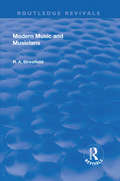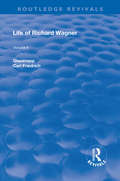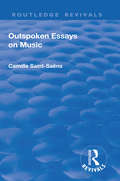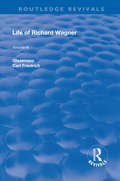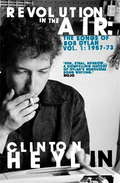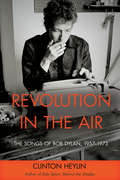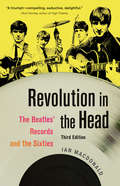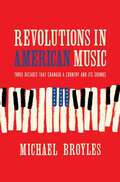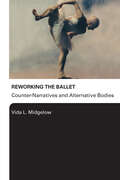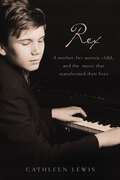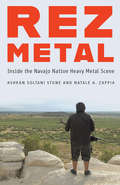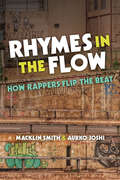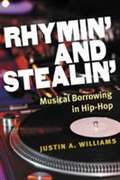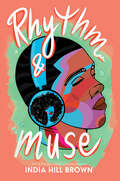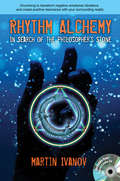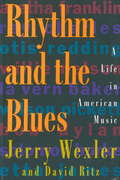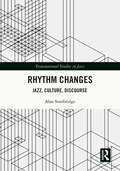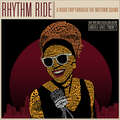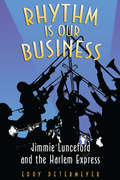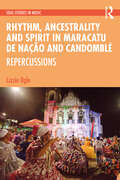- Table View
- List View
Revival: Modern Music and Musicians (Routledge Revivals)
by Richard Alexander StreatfieldA plethora of biographical accounts of some of the contemporary composers and musicians at the turn of the twentieth century.
Revival: Opera and Drama (Routledge Revivals)
by Carl Friedrich GlasenappThe second volume of Carl Friedrich Glasenapp's Life of Richard Wagner.
Revival: Outspoken Essays on Music (Routledge Revivals)
by Camille Saint-SaensA series of essays on reactions and emotional responses to music.
Revival: The Art Work of the Future (Routledge Revivals)
by Carl Friedrich GlasenappThis volume brings our story down to 1843, an important era in Richard Wagner’s Life, with his entry, as composer, of two successful operas, upon a so-called "practical" career at one of the principal German theatres.
Revival: The Theatre (Routledge Revivals)
by Carl Francis GlasenappThird volume of Carl Francis Glasenapp's Life of Richard Wagner.
Revival: Their History and Character (Routledge Revivals)
by Francis W. GalphinThe study of musical instruments now no longer with us is necessary, not only for the musician and composer, but for the man of letters, the artist, and the chronicler of our national life; for many allusions to customs of bygone times cannot otherwise be understood, and we should be spared such a trying ordeal as we were recently subjected to by one of our leading illustrated papers, which introduced into a thirteenth century scene a twentieth century mandoline with an up to date mechanism.
Revolution in the Air: The Songs of Bob Dylan 1957-1973
by Clinton HeylinBob Dylan has always regarded himself as a songwriter: 'I am my words,' he wrote in 1964.Distilling a lifetime's passion and study, leading Dylan author, Clinton Heylin charts the development and first moments of genius of this unique artist whose songs changed the world.From his first attempts at writing, Song to Bridget, in 1957, (apparently for Brigitte Bardot) Bob Dylan always aspired to poetry, yet his role as a writer rather than a performer of his own songs is often overlooked. In over fifty years of creativity he had penned some of the most iconic, and perfect, songs in popular history. Arriving in New York in 1961, the city had an enormous impact on the young artist and, as he established himself amongst the folk clubs and artists, he would produce songs that spoke for a whole generation: Blowing in the Wind, A Hard Rain's Gonna Fall, The Times They Are a Changin', Like a Rolling Stone, and Forever Young.In Revolution in the Air Clinton Heylin recounts the story of each song as it is written, giving a full appreciation of the songs themselves as well as Dylan the emerging artist. Unlike any other book on Dylan, it charts his rise as a writer, where he gained his inspiration, the burst of energy which produced some of his most famous songs as well as the lesser known stories behind the more iconic verses.This is an essential book for anyone interested in Dylan and his place in literature. Informative, opinionated, packed with new insights and revelations, this is an instant classic.
Revolution in the Air: The Songs of Bob Dylan, 1957–1973
by Clinton HeylinBy far the most comprehensive book on Dylan's words ever written, including a number of songs that no one has ever heard, this first volume will fundamentally change how these lyrics are interpreted and understood. Arranged in a surprising chronology of when they were actually written rather than when they appeared on albums--the middle verse of "Blowin' in the Wind" was written much later than the first and third verses, and the songs on John Wesley Harding were written prior to some of the songs on The Basement Tapes--hundreds of surprising facts are uncovered in this catalog of 300 songs, spanning his career up prior to Blood on the Tracks. Newly discovered manuscripts, anecdotal evidence, and a seemingly limitless knowledge of every Bob Dylan live performance contribute to this definitive resource of the words of a celebrated American singer-songwriter.
Revolution in the Head: The Beatles' Records and the Sixties
by Ian MacdonaldThis "Bible of the Beatles" captures the iconic band's magical and mysterious journey from adorable teenagers to revered cultural emissaries. In this fully updated version, each of their 241 tracks is assessed chronologically from their first amateur recordings in 1957 to their final "reunion" recording in 1995. It also incorporates new information from the Anthology series and recent interviews with Paul McCartney. This comprehensive guide offers fascinating details about the Beatles' lives, music, and era, never losing sight of what made the band so important, unique, and enjoyable.
Revolutions in American Music: Three Decades That Changed a Country and Its Sounds
by Michael BroylesThe story of how unexpected connections between music, technology, and race across three tumultuous decades changed American culture. How did a European social dance craze become part of an American presidential election? Why did the recording industry become racially divided? Where did rock ’n’ roll really come from? And how do all these things continue to reverberate in today’s world? In Revolutions in American Music, award-winning author Michael Broyles shows the surprising ways in which three key decades—the 1840s, the 1920s, and the 1950s—shaped America’s musical future. Drawing connections between new styles of music like the minstrel show, jazz, and rock ’n’ roll, and emerging technologies like the locomotive, the first music recordings, and the transistor radio, Broyles argues that these decades fundamentally remade our cultural landscape in enduring ways. At the same time, these connections revealed racial fault lines running through the business of music, in an echo of American society as a whole. Through the music of each decade, we come to see anew the social, cultural, and political fabric of the time. Broyles combines broad historical perspective with an eye for the telling detail and presents a variety of characters to serve as focal points, including the original Jim Crow, a colorful Hungarian dancing master named Gabriel de Korponay, “Empress of the Blues” Bessie Smith, and the singer Johnnie Ray, whom Tony Bennett called “the father of rock ’n’ roll.” Their stories, and many others, animate Broyles’s masterly account of how American music became what it is today.
Reworking the Ballet: Counter Narratives and Alternative Bodies
by Vida L. MidgelowChallenging and unsettling their predecessors, modern choreographers such as Matthew Bourne, Mark Morris and Masaki Iwana have courted controversy and notoriety by reimagining the most canonical of Classical and Romantic ballets. In this book, Vida L. Midgelow illustrates the ways in which these contemporary reworkings destroy and recreate their source material, turning ballet from a classical performance to a vital exploration of gender, sexuality and cultural difference. Reworking the Ballet: Counter Narratives and Alternative Bodies articulates the ways that audiences and critics can experience these new versions, viewing them from both practical and theoretical perspectives, including: eroticism and the politics of touch performing gender cross-casting and cross-dressing reworkings and intertextuality cultural exchange and hybridity.
Rex: A Mother, Her Autistic Child, and the Music that Transformed Their Lives
by Cathleen Lewis<P>The inspiring story of Rex, a boy who is not only blind and autistic, but who also happens to be a musical savant. <P>How can an 11-year old boy hear a Mozart fantasy for the first time and play it back note-for-note perfectly-but struggle to navigate the familiar surroundings of his own home? <P>Cathleen Lewis says her son Rex's laugh of total abandon is the single most joyous sound anyone could hear, but his tortured aversion to touch and sound breaks her heart and makes her wonder what God could have had in mind. <P>In this book she shares the mystery of Rex and the highs, lows, hopes, dreams, joy, sorrows, and faith she has journeyed through with him.
Rez Metal: Inside the Navajo Nation Heavy Metal Scene
by Natale A. Zappia Ashkan Soltani StoneRez Metal captures the creative energy of Indigenous youth culture in the twenty-first century. Bridging communities from disparate corners of Indian Country and across generations, heavy metal has touched a collective nerve on the Navajo Reservation in Arizona in particular. Many cultural leaders—including former Navajo president Russell Begaye—have begun to recognize heavy metal&’s ability to inspire Navajo communities facing chronic challenges such as poverty, depression, and addiction. Heavy metal music speaks to the frustrations, fears, trials, and hopes of living in Indian Country.Rez Metal highlights a seminal moment in Indigenous heavy metal: when Kyle Felter, lead singer of the Navajo heavy metal band I Dont Konform, sent a demo tape to Flemming Rasmussen, the Grammy Award–winning producer of several Metallica albums, including Master of Puppets. A few months later, Rasmussen, captivated by the music, flew from Denmark to Window Rock, Arizona, to meet the band. Through a series of vivid images and interviews focused on the venues, bands, and fans of the Navajo Nation metal scene, Rez Metal provides a window into this fascinating world.
Rhymes in the Flow: How Rappers Flip the Beat
by Macklin Smith Aurko JoshiDespite its global popularity, rap has received little scholarly attention in terms of its poetic features. Rhymes in the Flow systematically analyzes the poetics (rap beats, rhythms, rhymes, verse and song structures) of many notable rap songs to provide new insights on rap artistry and performance. Defining and describing the features of what rappers commonly call flow, the authors establish a theory of the rap line as they trace rap’s deepest roots and stylistic evolution—from Anglo-Saxon poetry to Lil Wayne—and contextualize its complex poetics. Rhymes in the Flow helps explain rap’s wide appeal by focusing primarily on its rhythmic and thematic power, while also claiming its historical, cultural, musical, and poetic importance.
Rhymin' and Stealin': Musical Borrowing in Hip-Hop
by Williams Justin A.Rhymin’ and Stealin’ begins with a crucial premise: the fundamental element of hip-hop culture and aesthetics is the overt use of preexisting material to new ends. Whether it is taking an old dance move for a breakdancing battle, using spray paint to create street art, quoting from a famous speech, or sampling a rapper or 1970s funk song, hip-hop aesthetics involve borrowing from the past. By appropriating and reappropriating these elements, they become transformed into something new, something different, something hip-hop. Rhymin’ and Stealin’ is the first book-length study of musical borrowing in hip-hop music, which not only includes digital sampling but also demonstrates a wider web of references and quotations within the hip-hop world. Examples from Nas, Jay-Z, A Tribe Called Quest, Eminem, and many others show that the transformation of preexisting material is the fundamental element of hip-hop aesthetics. Although all music genres use and adapt preexisting material in different ways, hip-hop music celebrates and flaunts its “open source” culture through highly varied means. It is this interest in the web of references, borrowed material, and digitally sampled sounds that forms the basis of this book—sampling and other types of borrowing becomes a framework with which to analyze hip-hop music and wider cultural trends.
Rhythm & Muse
by India Hill BrownCinderella meets Cyrano in this pitch-perfect YA rom-com that is a celebration of Black joy, first crushes, and putting your heart on the line for love. Darren Johnson lives in his head. There, he can pine for his crush—total dream girl, Delia Dawson—in peace, away from the unsolicited opinions of his talkative family and showboat friends. When Delia announces a theme song contest for her popular podcast, Dillie D in the Place to Be, Darren’s friends—convinced he’ll never make a move—submit one of his secret side projects for consideration.After the anonymous romantic verse catches Dillie’s ear, she sets out to uncover the mystery singer behind the track. Now Darren must decide: Is he ready to step out of the shadows and take the lead in his own life?
Rhythm Alchemy
by Martin IvanovAccording to Socrates, humans have nothing more to learn because we already know everything we need to know. We have simply forgotten it. A true teacher is one who can help us to remember forgotten knowledge. The great Michelangelo perceived his unique creations in rough and uncultured stone blocks. He said that to see the finished sculpture, one only needs to eliminate the unnecessary particles and debris. Just like these stone blocks, we all possess hidden and forgotten wisdom. To live our true nature, we need to separate ourselves from our limited beliefs and understandings. This is the very essence of the book you have in your hands. #147;Rhythm Alchemy” is full of insights from ancient times and from our deepest self. The book synthesizes the ancient knowledge of numbers, the heartbeat, the rhythm of breathing and our personal situation within the bigger, universal vibrations, as well as our interactions with people and nature around us. #147;Rhythm Alchemy” offers invaluable knowledge about ourselves and the unique harmony between the human being, his or her inner world, his or her rhythm and the surrounding reality. We may not realize how often we use musical terms like rhythm, melody and harmony to refer to things which happen to us in our daily lives: the rhythm of our heart, how our feelings soar in space, the melody of our personal inner voice trying to interweave with the harmony of other voices around us. We are constantly seeking and wanting to write the composition of our "happiness". When we compose this work, even though we tirelessly seek inspiration from outside us, our score often stays blank. This is because we do not pay sufficient attention to the true inspiration which lies within us. In order to reach this inspiration, we need to rebuild the bridges linking us to the roots of our true nature #150; rhythm. When we begin the intimate dance with the vibrations of our existence and begin to experience the real flavor of each wave which colors our emotions, then we will attain the creative power of the composer expressed in what we call #147;happiness”. Martin Ivanov’s book "Rhythm Alchemy" provides us with the spiritual and physical parameters of our cosmic score. It will guide us to our place in the composition and provide us with the ideas and knowledge we need to participate fully in both #150; how to compose our life and fulfill our innermost dreams.
Rhythm And The Blues
by Jerry WexlerAtlantic Records partner and producer, Wexler presided over the evolution of the modern music business and made prodigious contributions through to our cultural history. Wexler has worked with the entire range of American genius: Ray Charles, Aretha Franklin, Otis Redding, Bob Dylan, Willie Nelson, and others. 75 photographs.
Rhythm Changes: Jazz, Culture, Discourse
by Alan StanbridgeRhythm Changes: Jazz, Culture, Discourse explores the history and development of jazz, addressing the music, its makers, and its social and cultural contexts, as well as the various discourses – especially those of academic analysis and journalistic criticism – that have influenced its creation, interpretation, and reception. Tackling diverse issues, such as race, class, nationalism, authenticity, irony, parody, gender, art, commercialism, technology, and sound recording, the book’s perspective on artistic and cultural practices suggests new ways of thinking about jazz history. It challenges many established scholarly approaches in jazz research, providing a much-needed intervention in the current academic orthodoxies of Jazz Studies. Perhaps the most striking and distinctive aspect of the book is the extraordinary eclecticism of the wide-ranging but carefully chosen case studies and examples referenced throughout the text, from nineteenth century literature, through 1930s Broadway and film, to twentieth and twenty-first century jazz and popular music.
Rhythm Ride: A Road Trip Through the Motown Sound
by Andrea Davis Pickney<p>From award-winning author Andrea Davis Pinkney comes the story of the music that defined a generation and a movement that changed the world. <p>Berry Gordy began Motown in 1959 with an $800 loan from his family. He converted the garage of a residential house into a studio and recruited teenagers from the neighborhood-like Smokey Robinson, Mary Wells, Marvin Gaye, Stevie Wonder, and Diana Ross-to sing for his new label. Meanwhile, the country was on the brink of a cultural revolution, and one of the most powerful agents of change in the following decade would be this group of young black performers from urban Detroit. From Berry Gordy and his remarkable vision to the Civil Rights movement, from the behind-the-scenes musicians, choreographers, and song writers to the most famous recording artists of the century, Andrea Davis Pinkney takes readers on a Rhythm Ride through the story of Motown.</p>
Rhythm Ride: A Road Trip Through the Motown Sound
by Andrea Davis PinkneyFrom award-winning author Andrea Davis Pinkney comes the story of the music that defined a generation and a movement that changed the world.Berry Gordy began Motown in 1959 with an $800 loan from his family. He converted the garage of a residential house into a studio and recruited teenagers from the neighborhood-like Smokey Robinson, Mary Wells, Marvin Gaye, Stevie Wonder, and Diana Ross-to sing for his new label. Meanwhile, the country was on the brink of a cultural revolution, and one of the most powerful agents of change in the following decade would be this group of young black performers from urban Detroit. From Berry Gordy and his remarkable vision to the Civil Rights movement, from the behind-the-scenes musicians, choreographers, and song writers to the most famous recording artists of the century, Andrea Davis Pinkney takes readers on a Rhythm Ride through the story of Motown.
Rhythm Science (Mediaworks Pamphlets)
by Paul D. MillerThe art of the mix creates a new language of creativity."Once you get into the flow of things, you're always haunted by the way that things could have turned out. This outcome, that conclusion. You get my drift. The uncertainty is what holds the story together, and that's what I'm going to talk about."—Rhythm ScienceThe conceptual artist Paul Miller, also known as Dj Spooky that Subliminal Kid, delivers a manifesto for rhythm science—the creation of art from the flow of patterns in sound and culture, "the changing same." Taking the Dj's mix as template, he describes how the artist, navigating the innumerable ways to arrange the mix of cultural ideas and objects that bombard us, uses technology and art to create something new and expressive and endlessly variable. Technology provides the method and model; information on the web, like the elements of a mix, doesn't stay in one place. And technology is the medium, bridging the artist's consciousness and the outside world.Miller constructed his Dj Spooky persona ("spooky" from the eerie sounds of hip-hop, techno, ambient, and the other music that he plays) as a conceptual art project, but then came to see it as the opportunity for "coding a generative syntax for new languages of creativity." For example: "Start with the inspiration of George Herriman's Krazy Kat comic strip. Make a track invoking his absurd landscapes...What do tons and tons of air pressure moving in the atmosphere sound like? Make music that acts a metaphor for that kind of immersion or density." Or, for an online "remix" of two works by Marcel Duchamp: "I took a lot of his material written on music and flipped it into a DJ mix of his visual material—with him rhyming!" Tracing the genealogy of rhythm science, Miller cites sources and influences as varied as Ralph Waldo Emerson ("all minds quote"), Grandmaster Flash, W. E. B Dubois, James Joyce, and Eminem. "The story unfolds while the fragments coalesce," he writes. Miller's textual provocations are designed for maximum visual and tactile seduction by the international studio COMA (Cornelia Blatter and Marcel Hermans). They sustain the book's motifs of recontextualizing and relayering, texts and images bleed through from page to page, creating what amount to 2.5 dimensional vectors. From its remarkable velvet flesh cover, to the die cut hole through the center of the book, which reveals the colored nub holding in place the included audio CD, Rhythm Science: Excerpts and Allegories from the Sub Rosa Archives, this pamphlet truly lives up to Editorial Director Peter Lunenfeld's claim that the Mediawork Pamphlets are "theoretical fetish objects...'zines for grown-ups."
Rhythm and Heritage in Modern Flamenco Guitar (Elements in Music since 1945)
by Carlos van TongerenDiscourses about rhythmic skill and feel have often been associated with forms of non-Western, and especially African and Afro-diasporic identity and heritage. How can we rethink rhythmic skill for the contemporary world where concepts of heritage and belonging are attaining new meanings across cultural and geographical borders? This Element addresses this question through the case study of modern flamenco guitar, an instrumental practice that has achieved daunting levels of rhythmic sophistication and has been flourishing across the globe for decades, even before flamenco was inscribed into UNESCO's list of Intangible Cultural Heritage in 2010. Drawing on examples from local guitar traditions in Jerez de la Frontera and Morón de la Frontera and from an online guitar contest launched during the Covid-19 pandemic, this Element explores how rhythm can shape new ways of understanding and performing heritage in the global and digital age.
Rhythm is our Business: Jimmie Lunceford and the Harlem Express
by Eddy DetermeyerIn the 1930s, swing music reigned, and the Jimmie Lunceford Orchestra was the hottest and hippest attraction on the black dance circuits. Known for its impeccable appearance and infectious rhythms, Lunceford's group was able to out-swing and outdraw any band. For ten consecutive years, they were the best-loved attraction at Harlem's famed Apollo Theater. The group's hit recordings sold in the hundreds of thousands, and Jimmie Lunceford's band rivaled Ellington's for popularity in the African American community. Jimmie Lunceford was also an innovator, elevating big-band showmanship to an art and introducing such novel instruments as the electric guitar and bass. The band's arrangements, written by Sy Oliver, Edwin Wilcox, Gerald Wilson, Billy Moore, Jr., and Tadd Dameron, were daring and forward looking, influencing generations of big-band writers. Rhythm Is Our Business traces the development of the Jimmie Lunceford Orchestra from its infant days as a high school band in Memphis to its record-breaking tours across the United States, Canada, and Europe. The book also unveils Lunceford's romantic yet ill-fated involvement with Yolande Du Bois, daughter of famous writer and opinion leader W.E.B. Du Bois. And by reconstructing Lunceford's last day, the book offers a glimpse into the mysteries surrounding the leader's untimely death. This is essential reading for anyone interested in the history and legacy of swing.
Rhythm, Ancestrality and Spirit in Maracatu de Nação and Candomblé: Repercussions (ISSN)
by Lizzie OgleRhythm, Ancestrality and Spirit in Maracatu de Nação and Candomblé: Repercussions examines how the highly percussive carnival practice of Maracatu de nação – an Afro-Brazilian musical and spiritual tradition originating in the north- eastern state of Pernambuco – has evolved in relation to the cosmology of Candomblé Nagô in the urban centres of Recife and Olinda, Brazil.Offering one of the first detailed ethnographic explorations into maracatu de nação, Candomblé Nagô and the connections between them, this book is a collaborative enquiry into frequently negated sacred and ancestral knowledge systems central to Afro-Brazilian musical-spiritual practices. Using an innovative research framework which integrates musical and rhythmic practices with spiritual, ancestral and ecological knowledge systems, readers are provided with an intimate ethnography based on eight years of friendship and learning with the oldest continuously active maracatu group in the world, Nação Leão Coroado, and its most recent leader, Mestre Afonso Aguiar (1948– 2018).This is a valuable text for those interested in ethnomusicology, performance studies, religious and cultural anthropology, decolonial research methods and writing styles, eco- musicology and Afro-diasporic, Brazilian and Latin American studies.
